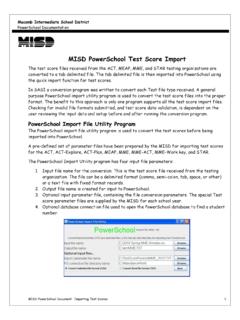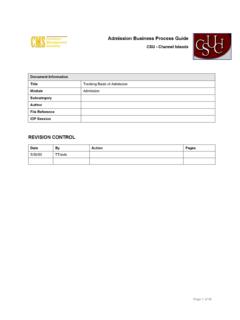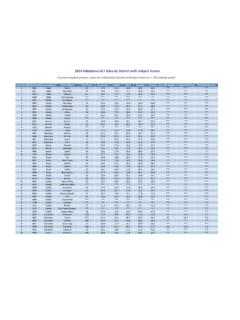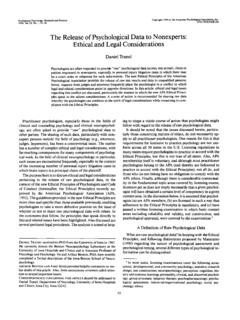Transcription of Show Me the Data - ClimateChangeLIVE
1 17 BirdSleuth: Investigating Evidence Teacher s GuideBefore You StartTime and Place 90 minutes, more if you explore eBird data IndoorsMATERIALS NEEDEDR esource Pages Graphs of Bird data handout Graphing My data article The I Wonder Kid handoutJournal Pages 7 11 Other Curriculum Components NoneYou Provide Graph paper Internet accessGetting Ready Copy the Reference Guide articles for each student. Make a color transparency or class handouts of Graphs of Bird data , or prepare to project it for the 3 show Me the DataGoalStudents will use graphing techniques to visually represent Objectives1. Students will be able to correctly identify and describe four kinds of graphs commonly used in science: pie charts, line graphs, scatter plots, and bar Students will be able to draw an appropriate example of a pie chart, line graph, scatter plot, and bar graph to repre-sent Students will be able to explain how the four types of graphs are used to represent different kinds of Outline1.
2 Introduce Look at real world graph Discuss choosing the right kind of Generate class Become an eBird data sleuth (optional).6. Think on Your Own: complete another the Activity1. Introduce graphs. Remind the students that in Investigation 2, they saw ex-amples of bar graphs in Amy s Scientific Report, and dif-ferent kinds of graphs in the Answering Your Scientific Questions article. Begin with a class discussion about how and why people use questions such as Have you ever made a graph? Why do people make graphs? Can you name any types of graphs? (Make sure that bar, line, and pie/circle graphs have been mentioned.) Why do you think that information is often presented in graphs instead of just in lists or tables? (Graphs visually show relation-ships between variables.)
3 00:90 BirdSleuth: Investigating Evidence Teacher s Guide18 Cornell Lab of Ornithology2. Look at real world graph samples. Display an overhead or give each student the Graphs of Bird data handout (REFER-ENCE PAGE 16) that illustrates four kinds of graphs you will focus on: pie, line, scat-ter, and bar. Ask students to compare and contrast the graphs, focusing on how the data are presented and any differences they might notice between the kinds of data pre-sented in each. You may wish to create a Venn diagram to il-lustrate similarities and differences between pairs of graph types, and ask students to tell what they think the graphs Me the DataREFERENCE PAGE 1616 BirdSleuth: Investigating Evidence Resource MaterialsCornell Lab of OrnithologyGraphs of Bird DataPie ChartsTypes of birds we counted this monthsongbirdswater birdsshorebirdsbirds of preyotherBar Graphs020406080100120 MinnesotaNew YorkIllinoisIndianaStatePercentage of feeders visited by Northern Cardinals in four statesPercentage of feeders visitedGroup sizes of American Crows in New York stateWeek Starting onAverage Count1/12/13/14/15/16/17/18/19/110/111/1 12/10246810121416182022 Line GraphsThe effect of temperature on the numberof bird feeder visits in winterNumber of visitsTemperature ( C)051015200102030 Scatter PlotsBirdSleuth: Investigating Evidence Teacher s Guide19 Cornell Lab of OrnithologyName: Date:7 BirdSleuth.
4 Investigating Evidence Investigator s JournalShow Me the DataPractice representing data using different types of of GraphsAfteraclassdiscussionaboutgraphs, of GraphWhen to Use This GraphPie ChartLine GraphScatter PlotBar GraphJOURNAL PAGE 7 show Me the Data3. Discuss choosing the right kind of graph. Have students read Graphing my data (REFERENCE GUIDE PAGES 17 21). Review the terms Independent Vari-able and Dependent Variable if neces-sary. Discuss ways that different types of graphs are better at illustrating different kinds of data . Make the following points by appropriately referencing the four Graphs of Bird data graphs: Line graphs are especially helpful for showing how something changes over time. Scatter Plots are similar, and good for showing trends in data .
5 They show how much one variable is affected by another. Bar graphs are used to compare two or more categories of things. Line, bar, and scatter plot graphs all have a dependent variable that is measured and plotted on the y-axis. Line graphs are preferred for showing changes over time because they bet-ter represent a continuum of data . In-formation presented in a bar graph is divided into categories. Pie charts show proportions and al-ways add to 100%. Students should record these ideas in the table on JOURNAL PAGE may wish to discuss the What Do You Think? questions scattered throughout the article, or ask students to submit writ-Placeholder textBirdSleuth: Investigating Evidence Resource Materials17 Graphing My DataYou ve probably heard the phrase, A picture is worth a thousand words.
6 A well-made graph is worth a thousand words it summarizes your data and might even make it easy to see any trends in your data ! Graphing is all about showing people your data visually. There are many kinds of graphs. Not every kind of graph will be best for your data . Deciding on what kind of graph to draw, and how to draw it, can require thought which makes graphing a fun challenge! Here, you ll learn about four kinds of graphs and when to use each Charts When you can convert data to show percentages, you can use a pie chart. Remember that the pieces of a pie together make 100%. Types of birds we counted this monthsongbirdswater birdsshorebirdsbirds of preyotherFigure 1 WHAT DO YOU THINK? What is the most common kind of bird the students counted? What kind of bird was seen least often? Approximately what proportion of birds counted this month were water birds?
7 REFERENCE PAGE 17 BirdSleuth: Investigating Evidence Teacher s Guide20 Cornell Lab of OrnithologyShow Me the Dataten responses as part of your Generate class graphs. Practice making a sample graph of each type with simple class-generated data (see sam-ples below). Students should record a sample graph of each of the four kinds on JOURNAL PAGES 8 10. Pie Chart Examples to graph: what proportion of students choose a given favorite sport, bird, or food? See the sample pie chart, Figure 1. Steps for making a pie chart:1. Collect the data and organize them in a table with column and row headings (see Table 1). Remember, pie charts are used to display percentages and the total of all categories always adds up to 100%. 2. Calculate the proportions and circle degrees for each item in the table (for younger students, calculating circle de-grees is not necessary; estimating and drawing the proportions will suffice).
8 3. Draw a circle to represent a pie chart. 4. Transfer the data to the graph by drawing segments in the chart. Distin-guishing sections by color is the stan-dard way to tell them Decide on a title for the pie chart. The title should go at the top and summa-rize the variables cafeteria foodNumber of studentsPercentage of studentsCircle degrees (% x 360)Pizza840%144 Hamburgers525%90 Chicken Nuggets315%54 Other 420%72 Total20100%360 Favorite cafeteria foodPizzaHamburgersChicken NuggetsOther FoodName: Date:BirdSleuth: Investigating Evidence Investigator s Journal8 Cornell Lab of OrnithologyShow me the DataFun with Graphs!Followalongwithyourclasstocomplet eanexampleofapiechart,linegraph,scatterp lot, : Questionyouaretryingtoanswer Titleforyourgraph Labelsforxandyaxes(line,bar,andscatterpl ots) Scalemeasurementsforxandyaxes(lineandbar graphs,scatterplots) Keyorlegend Datatable(optional)1.
9 Pie ChartQuestiontographJOURNAL PAGE 8 Table 1: Table of favorite cafeteria foodsFigure 1: Sample pie chartBirdSleuth: Investigating Evidence Teacher s Guide21 Cornell Lab of Ornithology6. Create a key to identify the sections of the pie chart. Line Graph Examples to graph: a student s growth in height or weight since birth, the daily high temperature over the course of last week. See Figure 2 for an example. Steps for making a line graph:1. Collect the data and organize them in a table with column and row head-ings (see Table 2).2. Draw a right angle on the board to represent the graph Label the x and y axes of the graph. Lay out the scales for each axis (for the example below: height in inches, 0 60, age in years, 1 10).4. Transfer the data to the graph by add-ing data points and drawing a line through them.
10 5. Decide on a title for the graph. The show Me the DataKerry s height since age oneAge (in years)Height (in inches)1272323374405426457488508521054 How Kerry has grown since age oneAge (in years)Height (in inches)012345678010102030405060 Name: Date:BirdSleuth: Investigating Evidence Investigator s Journal9 Cornell Lab of OrnithologyPlaceholder textShow Me the Data2. Line GraphQuestiontograph3. Scatter PlotQuestiontographJOURNAL PAGE 9 Figure 2: Sample of line graphTable 2: Table of student s growthBirdSleuth: Investigating Evidence Teacher s Guide22 Cornell Lab of Ornithologytitle should go at the top and describe the relationship between the variables represented. Scatter Plots Scatter plots are best for showing whether two variables are correlated. Examples to graph: the number of hours that students spent studying for an exam versus the grade received (see Figure 3).










